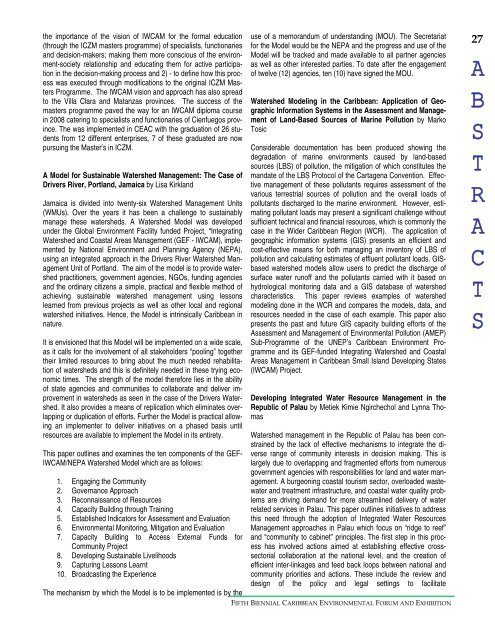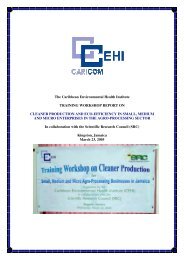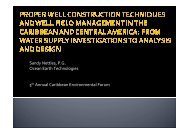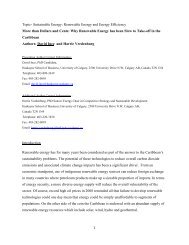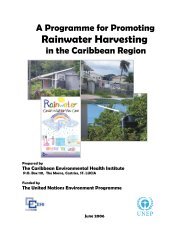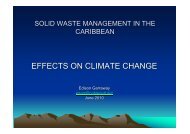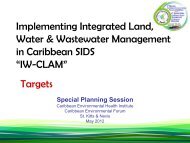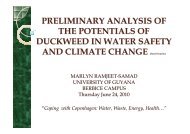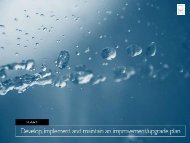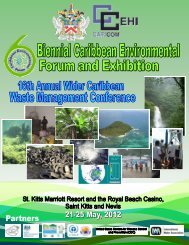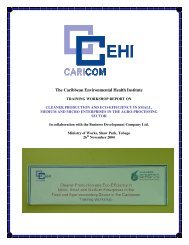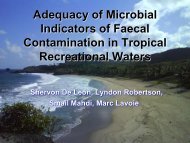conference magazine - Caribbean Environmental Health Institute
conference magazine - Caribbean Environmental Health Institute
conference magazine - Caribbean Environmental Health Institute
You also want an ePaper? Increase the reach of your titles
YUMPU automatically turns print PDFs into web optimized ePapers that Google loves.
the importance of the vision of IWCAM for the formal education<br />
(through the ICZM masters programme) of specialists, functionaries<br />
and decision-makers; making them more conscious of the environment-society<br />
relationship and educating them for active participation<br />
in the decision-making process and 2) - to define how this process<br />
was executed through modifications to the original ICZM Masters<br />
Programme. The IWCAM vision and approach has also spread<br />
to the Villa Clara and Matanzas provinces. The success of the<br />
masters programme paved the way for an IWCAM diploma course<br />
in 2008 catering to specialists and functionaries of Cienfuegos province.<br />
The was implemented in CEAC with the graduation of 26 students<br />
from 12 different enterprises, 7 of these graduated are now<br />
pursuing the Master’s in ICZM.<br />
A Model for Sustainable Watershed Management: The Case of<br />
Drivers River, Portland, Jamaica by Lisa Kirkland<br />
Jamaica is divided into twenty-six Watershed Management Units<br />
(WMUs). Over the years it has been a challenge to sustainably<br />
manage these watersheds. A Watershed Model was developed<br />
under the Global Environment Facility funded Project, “Integrating<br />
Watershed and Coastal Areas Management (GEF - IWCAM), implemented<br />
by National Environment and Planning Agency (NEPA),<br />
using an integrated approach in the Drivers River Watershed Management<br />
Unit of Portland. The aim of the model is to provide watershed<br />
practitioners, government agencies, NGOs, funding agencies<br />
and the ordinary citizens a simple, practical and flexible method of<br />
achieving sustainable watershed management using lessons<br />
learned from previous projects as well as other local and regional<br />
watershed initiatives. Hence, the Model is intrinsically <strong>Caribbean</strong> in<br />
nature.<br />
It is envisioned that this Model will be implemented on a wide scale,<br />
as it calls for the involvement of all stakeholders “pooling” together<br />
their limited resources to bring about the much needed rehabilitation<br />
of watersheds and this is definitely needed in these trying economic<br />
times. The strength of the model therefore lies in the ability<br />
of state agencies and communities to collaborate and deliver improvement<br />
in watersheds as seen in the case of the Drivers Watershed.<br />
It also provides a means of replication which eliminates overlapping<br />
or duplication of efforts. Further the Model is practical allowing<br />
an implementer to deliver initiatives on a phased basis until<br />
resources are available to implement the Model in its entirety.<br />
This paper outlines and examines the ten components of the GEF-<br />
IWCAM/NEPA Watershed Model which are as follows:<br />
1. Engaging the Community<br />
2. Governance Approach<br />
3. Reconnaissance of Resources<br />
4. Capacity Building through Training<br />
5. Established Indicators for Assessment and Evaluation<br />
6. <strong>Environmental</strong> Monitoring, Mitigation and Evaluation<br />
7. Capacity Building to Access External Funds for<br />
Community Project<br />
8. Developing Sustainable Livelihoods<br />
9. Capturing Lessons Learnt<br />
10. Broadcasting the Experience<br />
The mechanism by which the Model is to be implemented is by the<br />
use of a memorandum of understanding (MOU). The Secretariat<br />
for the Model would be the NEPA and the progress and use of the<br />
Model will be tracked and made available to all partner agencies<br />
as well as other interested parties. To date after the engagement<br />
of twelve (12) agencies, ten (10) have signed the MOU.<br />
Watershed Modeling in the <strong>Caribbean</strong>: Application of Geographic<br />
Information Systems in the Assessment and Management<br />
of Land-Based Sources of Marine Pollution by Marko<br />
Tosic<br />
Considerable documentation has been produced showing the<br />
degradation of marine environments caused by land-based<br />
sources (LBS) of pollution, the mitigation of which constitutes the<br />
mandate of the LBS Protocol of the Cartagena Convention. Effective<br />
management of these pollutants requires assessment of the<br />
various terrestrial sources of pollution and the overall loads of<br />
pollutants discharged to the marine environment. However, estimating<br />
pollutant loads may present a significant challenge without<br />
sufficient technical and financial resources, which is commonly the<br />
case in the Wider <strong>Caribbean</strong> Region (WCR). The application of<br />
geographic information systems (GIS) presents an efficient and<br />
cost-effective means for both managing an inventory of LBS of<br />
pollution and calculating estimates of effluent pollutant loads. GISbased<br />
watershed models allow users to predict the discharge of<br />
surface water runoff and the pollutants carried with it based on<br />
hydrological monitoring data and a GIS database of watershed<br />
characteristics. This paper reviews examples of watershed<br />
modeling done in the WCR and compares the models, data, and<br />
resources needed in the case of each example. This paper also<br />
presents the past and future GIS capacity building efforts of the<br />
Assessment and Management of <strong>Environmental</strong> Pollution (AMEP)<br />
Sub-Programme of the UNEP’s <strong>Caribbean</strong> Environment Programme<br />
and its GEF-funded Integrating Watershed and Coastal<br />
Areas Management in <strong>Caribbean</strong> Small Island Developing States<br />
(IWCAM) Project.<br />
Developing Integrated Water Resource Management in the<br />
Republic of Palau by Metiek Kimie Ngirchechol and Lynna Thomas<br />
Watershed management in the Republic of Palau has been constrained<br />
by the lack of effective mechanisms to integrate the diverse<br />
range of community interests in decision making. This is<br />
largely due to overlapping and fragmented efforts from numerous<br />
government agencies with responsibilities for land and water management.<br />
A burgeoning coastal tourism sector, overloaded wastewater<br />
and treatment infrastructure, and coastal water quality problems<br />
are driving demand for more streamlined delivery of water<br />
related services in Palau. This paper outlines initiatives to address<br />
this need through the adoption of Integrated Water Resources<br />
Management approaches in Palau which focus on “ridge to reef”<br />
and “community to cabinet” principles. The first step in this process<br />
has involved actions aimed at establishing effective crosssectorial<br />
collaboration at the national level, and the creation of<br />
efficient inter-linkages and feed back loops between national and<br />
community priorities and actions. These include the review and<br />
design of the policy and legal settings to facilitate<br />
FIFTH BIENNIAL CARIBBEAN ENVIRONMENTAL FORUM AND EXHIBITION<br />
27<br />
A<br />
B<br />
S<br />
T<br />
R<br />
A<br />
C<br />
T<br />
S


